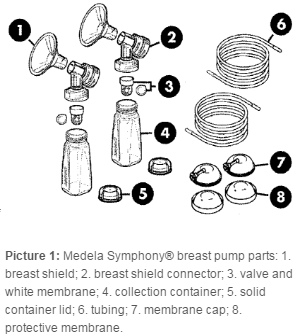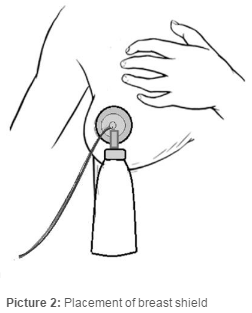Breast Milk for Your Hospitalized Infant: Electric Breast Pump
Neonatology
Looking for services or physicians who can help treat this condition?
![]()
Mothers who need to express milk for many weeks or months while their babies are in the hospital will need to use a “hospital grade” electric breast pump. These pumps have a “closed system.” If needed, more than one person can use them. They have a filter system that stops your milk from getting into the machine. This prevents your breast milk from mixing with another mom’s milk if she uses the pump after you.
There are many brands of electric breast pumps. The Medela Symphony® is the one used at Nationwide Children's Hospital and in NICUs staffed by Nationwide Children’s Hospital.
Your insurance may pay to rent an electric pump. You will need to have a prescription. For information or help with renting an electric pump, call the Nationwide Children’s Hospital lactation team at 614-722-5228, or the lactation team where your child is hospitalized.
When to Use the Pump
Begin pumping as soon as possible. You should pump 8 times every 24 hours with no more than a 5 to 6 hour break at night for sleep. If you wake up in the night, you should pump. (For more information on how to care for your breasts, see Helping Hand HH-IV-61 Breast Care and Expressing Milk.)
Pumping with an Electric Breast Pump
Before using the electric pump, get to know the parts (Picture 1).
A nurse or a member of the lactation team will teach you how to use the pump. The outside of the pump needs to be wiped down with aseptic wipes both before and after each use. Once the outside of the pump has been cleaned:
- Wash your hands well with soap and water for 15 seconds.

- Put the parts together.
- Place the breast shield of the pump over each nipple (Picture 2).
- Turn the pump on. Turn it up to the highest level of comfort.
- Pump both of your breasts at the same time for 15 to 20 minutes.
- Pumping should not hurt. If you have pain while pumping, contact the lactation team.
Safe Storage and Use of Expressed Milk
- Pour the milk into sterile containers given to you at the hospital. Use only one container each time you express milk.
- Do not add newly expressed milk to a container that already has stored milk.
- While your baby is in the hospital, all bottles must be labeled with:
- Baby’s full name
- Date and time of milk collection
- Baby’s medical record number
- Medicines taken by mother in past 24 hours
- Store your breast milk based on the plan developed by you and your health provider. It can be either refrigerated or frozen. For information about storing breast milk now and when your baby goes home, see Helping Hand HH-IV-61 Breast Care and Expressing Milk.
- Expressed milk should be kept in the refrigerator for only 48 hours.
- Milk may be kept frozen for 3 months in your home refrigerator’s freezer or for 12 months in a deep freezer.
- To bring milk to the hospital, pack it with freezer packs in a cooler. Bring only frozen or refrigerated milk.
- Do not thaw the milk before coming. When you arrive at the hospital, give your breast milk to a staff member to store in the refrigerator or freezer.
- Throw away any milk left in the bottle after feeding.
- Milk should not be refrozen once thawed.
- When your baby leaves the hospital, you may combine your stored breast milk into one bottle. Breast milk stored after different feedings can be combined if the milk is the same temperature. For guidelines on thawing and combining milk, see Helping Hand HH-IV-61 Breast Care and Expressing Milk.
Equipment Care: Washing and Rinsing the Pump and Pump Parts
You must have clean equipment to provide your baby with a safe supply of your milk. For all infants, the outside of the pump needs to be wiped down with aseptic wipes before and after each use.
- Always wear nonsterile gloves to protect your skin from irritation when touching aseptic wipes.
- After cleaning the pump, allow it to dry for 3 minutes before using it. This allows enough time for the chemical in the wipes to kill bacteria on the surface of the pump.
All pump parts that come in contact with breast milk need to be washed after each use. These are the breast shield, breast shield connector, valve and white membrane, collection container and the solid container lid (Picture 1).
If your baby is in an intensive care unit (ICU, NICU, CTICU, PICU), Special Care Nursery or has a weakened immune system, the way to clean the equipment is different than for other hospitalized babies.
To clean pump parts after expressing milk:
- Wash your hands with warm, soapy water.
- Separate pump parts and collection bottles.
- Put aside parts that do not need to be washed. The tubing, membrane cap and protective membrane usually do not need cleaning unless they come in contact with breast milk. (Picture 1, pump parts 6, 7, and 8). Notify your baby’s nurse or a lactation specialist if this happens.
- Place the pump parts to be washed in a basin provided by the hospital.
- Choose any liquid dish soap. Avoid soaps made for hands or body that have fragrances, lotions, alcohol, or other additives. These chemicals may enter the milk.
- Wash pump parts and collection bottles in dish soap and water and then rinse thoroughly.
- For babies in an intensive care unit, Special Care Unit or who have a weakened immune system, only wash and rinse with sterile water.
- For hospitalized babies in other areas, use hot tap water. You can wash and rinse the pump parts at the hospital or at home using hot tap water.
- Well water is not recommended to wash or rinse pump parts.
- After washing pump parts, wash basin with dish soap and water. Use sterile water to wash and rinse the basin if your baby is in the intensive care unit, Special Care Nursery or has a weakened immune system.
- Allow parts and bottles to dry on clean paper towels.
Equipment Care: Sterilization
Electric pump equipment that comes in contact with breast milk needs to be sterilized once every 24 hours.
Before sterilizing, the equipment needs to be washed and rinsed:
- Wash the pump parts thoroughly following steps 1 through 6 on the previous page.
- Begin to sterilize the pump parts. Choose one of these three ways to do this:
- Use the Medela Quick Clean™ Micro-Steam bag. Follow the manufacturer’s directions on the package.
- When you sterilize in the hospital, the micro-steam bag can be used only one time. Save the micro-steam bag to use again, away from the hospital.
- When you sterilize away from the hospital, the micro-steam bags can be used up to 20 times.
- Use a dishwasher. Pump parts can be washed on the hot water cycle with dishes.
- Boil pump parts in rapidly boiling water for 10 minutes.
- Remember, well water is not recommended for use.
- Use the Medela Quick Clean™ Micro-Steam bag. Follow the manufacturer’s directions on the package.
- Allow parts and bottles to dry on clean paper towels.
- Parts can be taken to the hospital in a clean Ziploc® bag or plastic food container.
If you have any questions, please call the lactation team at (614) 722-5228.
HH-IV-85 2/05 Revised 3/16 Copyright 2005, Nationwide Children’s Hospital
